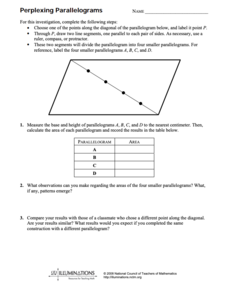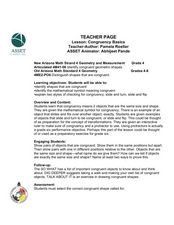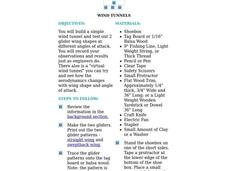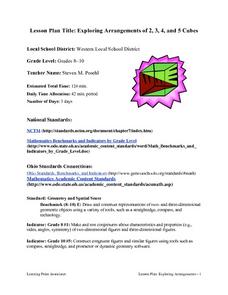Curated OER
Making Parallel Lines
Students differentiate between parallel and perpendicular lines. In this geometry lesson plan, students make conjectures and apply it to solve real life situations. They collect data and make predictions based on the data.
Curated OER
Musical Genre Pie Charts
In this pie chart worksheet, students transpose musical genre data to the charts and then answer questions about the results.
Curated OER
Have You Got The Angle?
In this angle worksheet, students complete a set of 10 multiple choice questions. An answer link is provided; page is labeled as a "post test."
National Council of Teachers of Mathematics
Perplexing Parallelograms
In this geometry worksheet, young mathematicians divide a parallelogram into four, by choosing points along a diagonal. Students calculate the area of each parallelogram and look for any patterns that may emerge. The one-page worksheet...
Curated OER
A Lesson on the Root Spiral
Students create lines and shapes with a compass and a straight edge. In this geometry lesson, students investigate square roots, irrational numbers and spirals. They explore nature to see the shapes representing mathematics and geometric...
Curated OER
Measurement
Fifth graders measure specified distances when given perpendicular lines. In this measurement lesson plan, 5th graders draw the lines themselves.
Curated OER
Polygons
In this polygon learning exercise, learners draw various polygons according to given specifications and find angle sums. A website reference for additional resources is given.
Curated OER
Inscribed Angles
Students analyze inscribed angles and intercepted arcs and explore the relationships between the two. They investigate the properties of angles, arcs, chords, tangents, and secants to solve problems involving circles.
Curated OER
Congruency Basics
Fourth graders investigate congruent shapes. For this congruency lesson, 4th graders explore examples of congruent shapes. Students determine how to check for congruency by sliding or flipping the shape.
Curated OER
Those Amazing Seaworld Animals
Students research the animals at SeaWorld and then relate the info they have found into various types of graphs; line, circle and bar. This instructional activity combines math and science nicely. They access a website imbedded in this...
Curated OER
Hidden Jewels of Geometry
Pupils identify different geometric shapes, and arrange them artistically in original jewelry designs.
Alabama Learning Exchange
Trapezoids: What's Equal or Right About Them?
Pupils explore the concept of trapezoids. In this trapezoids instructional activity, students identify legs and bases of a trapezoid. Pupils discuss the similarities and differences between isosceles trapezoids and right trapezoids. ...
Curated OER
Try An Angle
Fifth graders classify the different triangles by sides and angles. They discover how many different ways they can arrange 2, 3, 4 ...7 tangram pieces to create triangles. They classify and label the six triangles on their pattern sheet.
Curated OER
Wind Tunnels
Students build a simple wind tunnel and test out 2 glider wing shapes at different angles of attack. They record their observations and results just as engineers do. There also is a "virtual wind tunnel" they can try to test aerodynamic...
Curated OER
Exploring Arrangements of 2, 3, 4, and 5 Cubes
Students construct models of various tricubes, tetracubes, and pentacubes that are possible, classify n-cubes into different groupings, and draw these figures on isometric dot paper giving true perspective to what they visualize.
Curated OER
Wings and Othe Things
Students work in groups that are engaged in different activities at different times. They watch the video "Madagascar" and collect data pertaining to the Fish Eagle's arm spam. They work together to perform mathematical computations...
Curated OER
Mapping A Stream
Students participate in mapping an actual waterway. They include reach lengths, transects, compass reading, and scale determinations. They include windfalls, plant cover, types of streambed composition, and landmarks such as trees and...
Curated OER
Estimate and Measure Angles
In this angle worksheet, students estimate a set of angles within 15 degrees, then measure each angle and name it. A reference web site is given for additional activities.
Curated OER
Estimate, Name and Measure Angles
In this angles worksheet, students first estimate then measure and name a set of 3 given angles. A reference web site is given for additional activities.
Curated OER
Estimating, Measuring and Naming Angles
In this angle instructional activity, students first estimate, then measure within 15 degrees and name a set of 3 angles. A reference web site is given for additional activities.
Curated OER
Our Class Record Book
Second graders, in groups, prepare a list of proposed record ideas for the class book.
Curated OER
Team Puzzles
Fourth graders work in co-operative teams of four to complete a puzzle. Each student initially works independently, and then the team jointly puts together the four shapes they have individually made, to complete the puzzle.

























